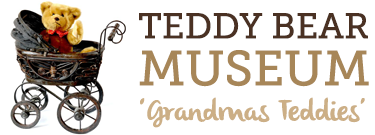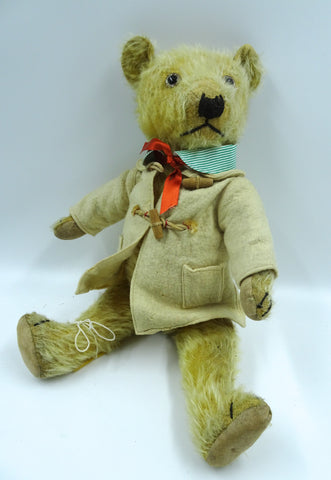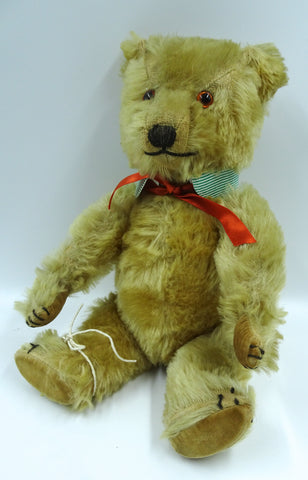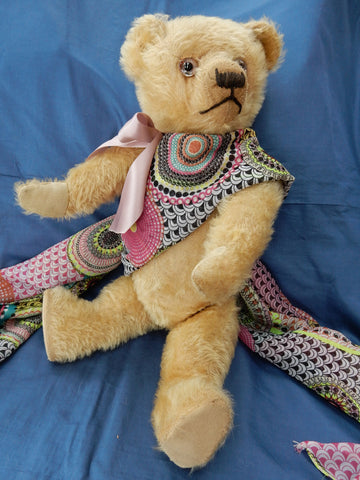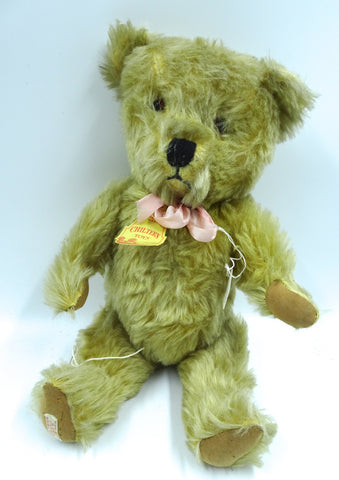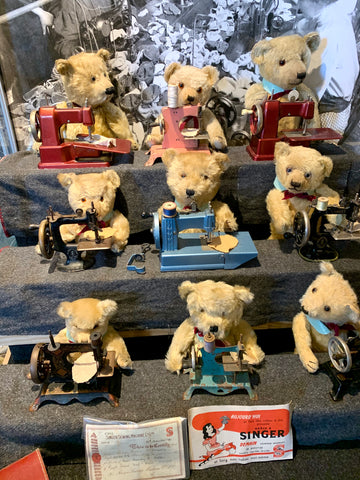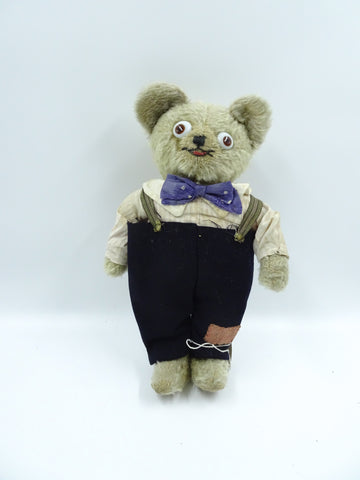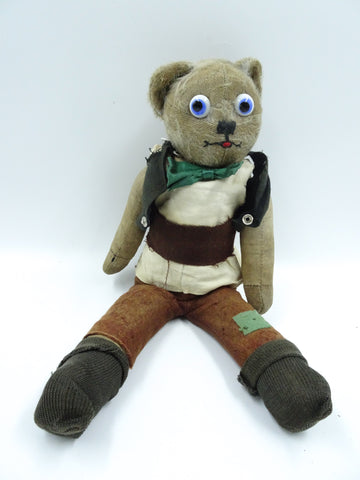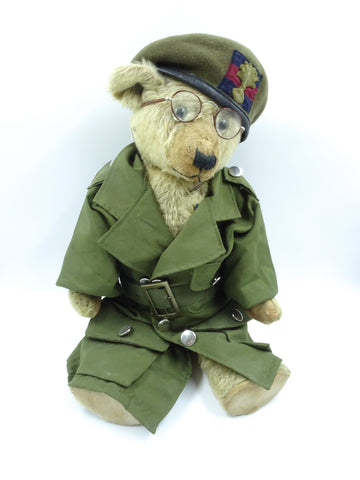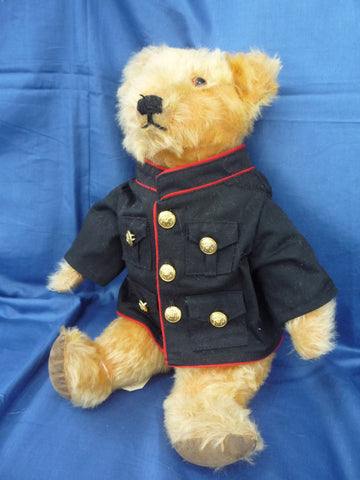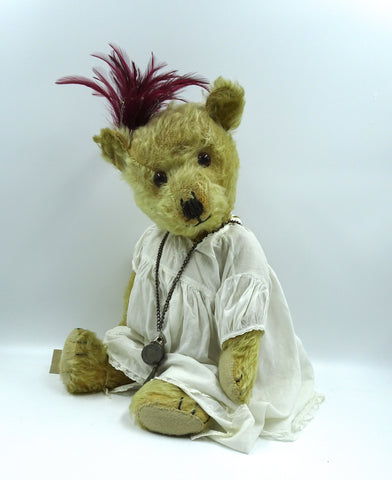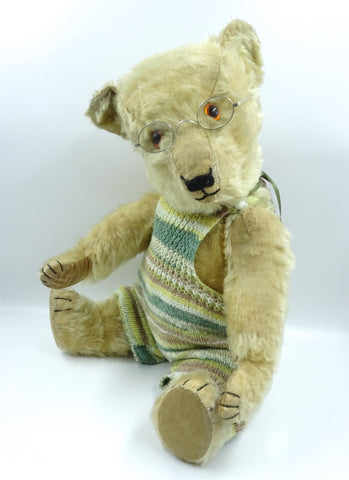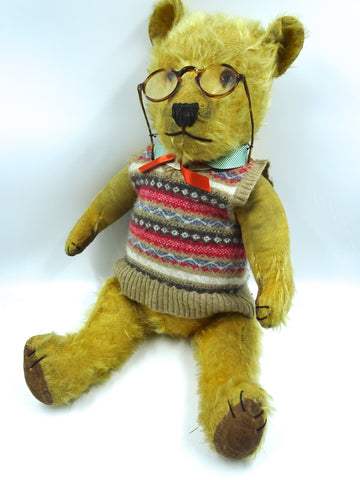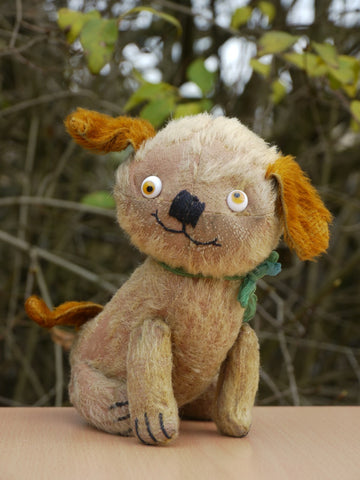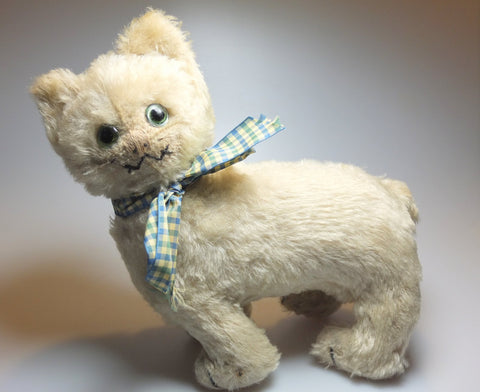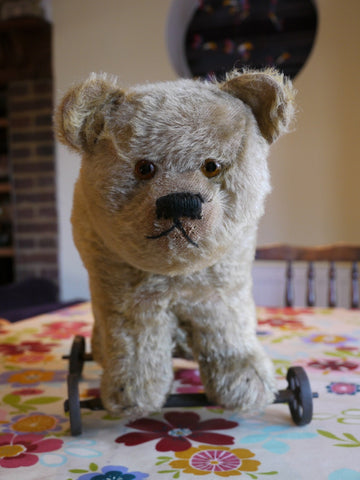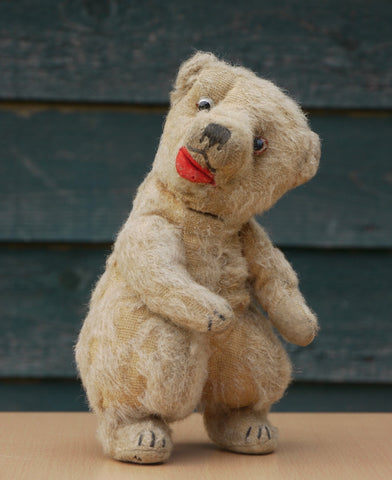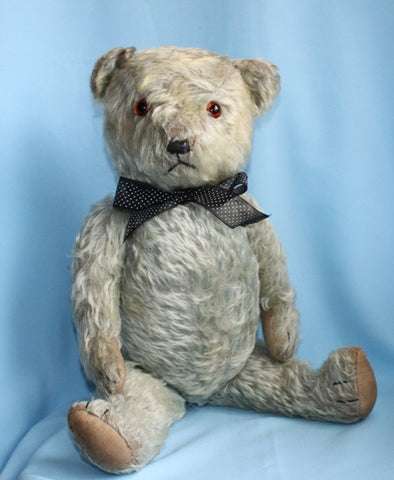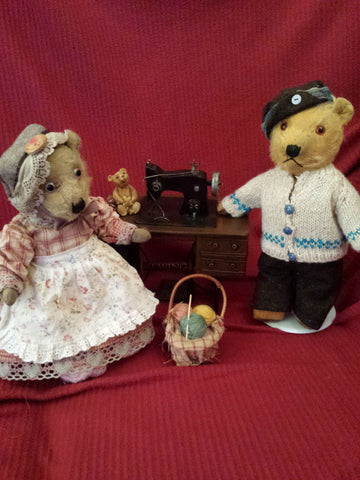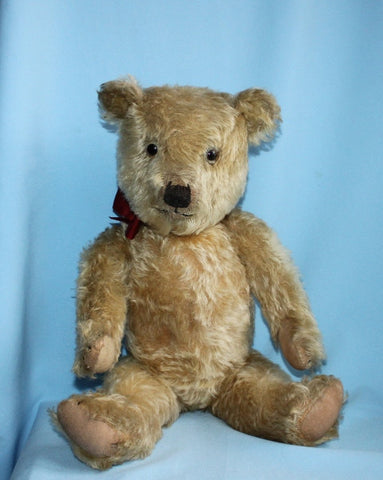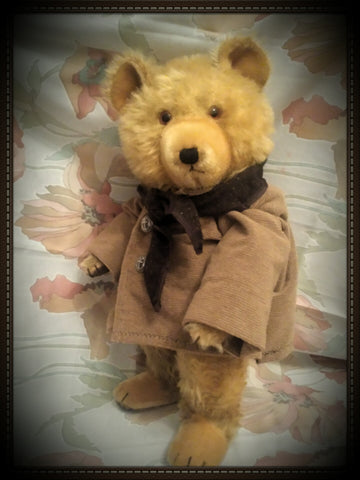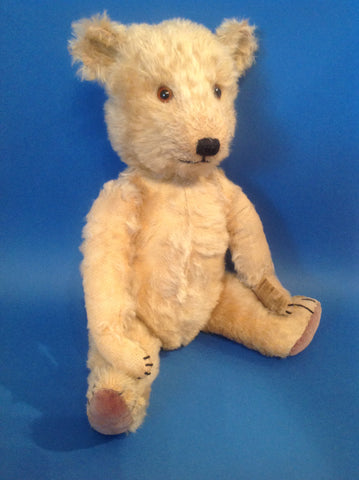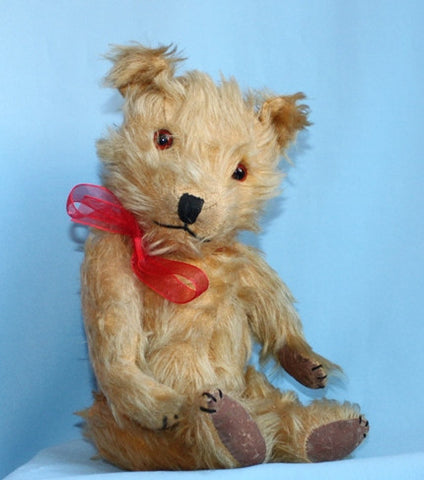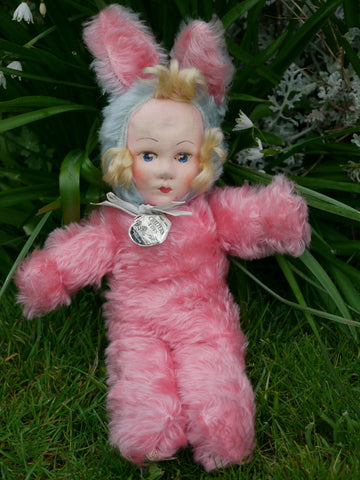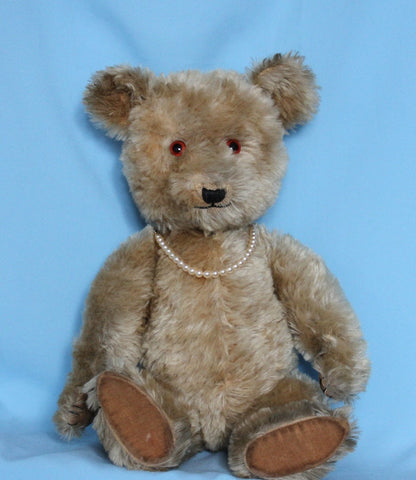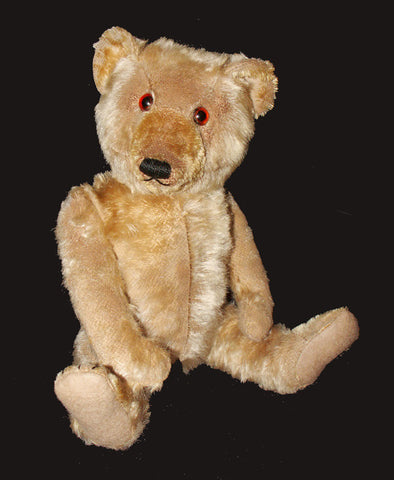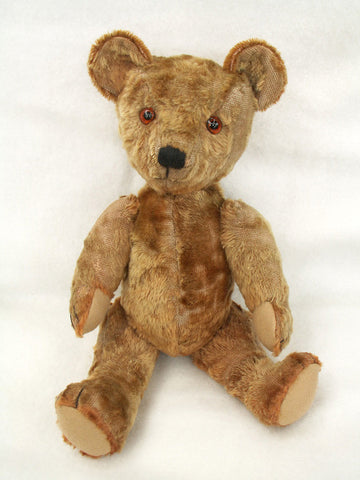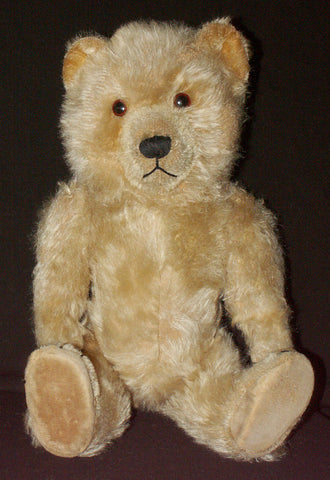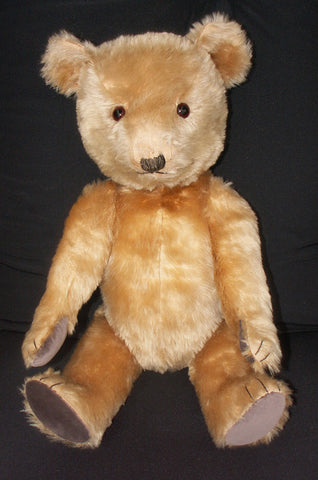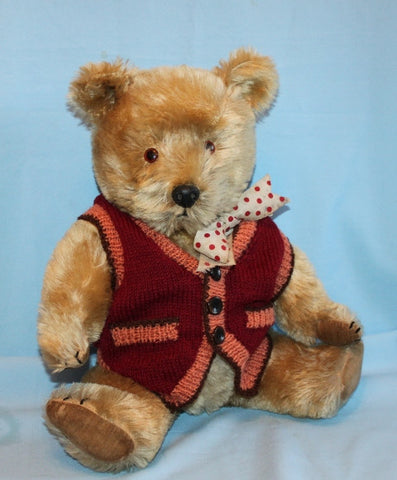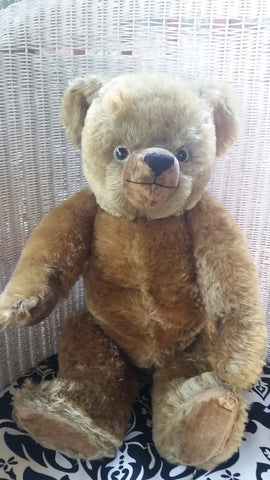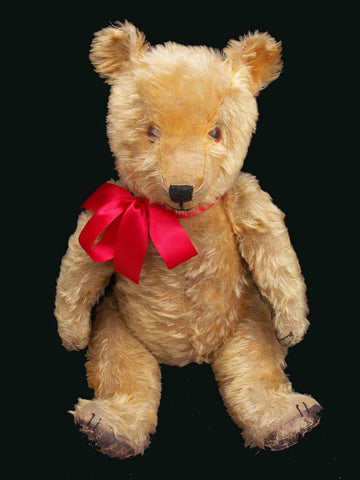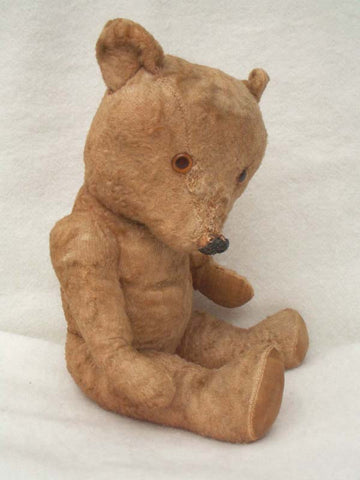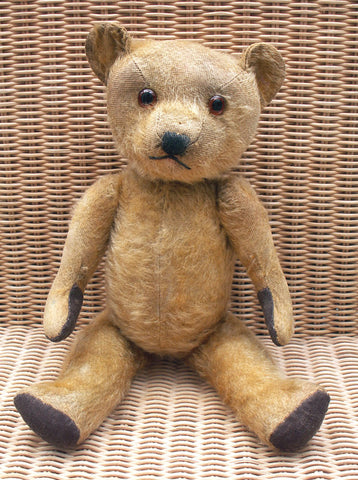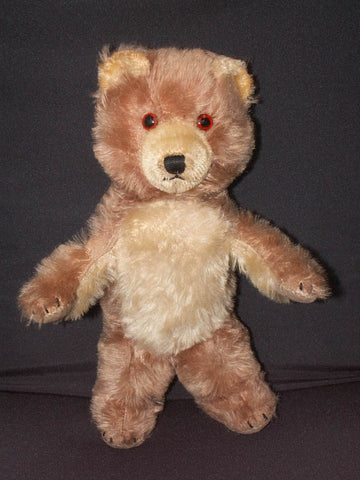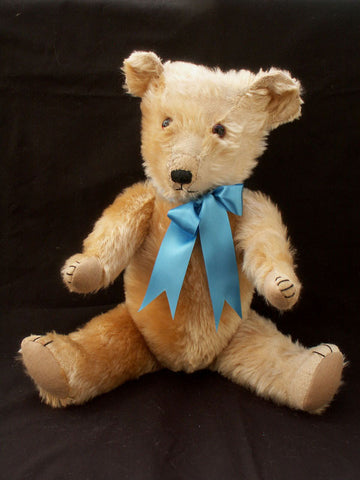Chiltern and Chiltern type
Chiltern or Chiltern Toy Works started in Chesham in Buckinghamshire in 1908 by Joseph Eisenmann. The first teddy was produced in 1915. When Joseph died in 1919, the factory was left to Leon Rees, his son in law. Leon moved to Waterside in Chesham a year later and in partnership with Harry Stone formed H.G. Stone and Co. Ltd. They opened a second factory in Tottenham, London in 1921.
One of the most popular Chiltern teddy bears was the Hugmee range of bears introduced in 1923. A year later in 1924, Chiltern Toys was registered. Manufacturing moved to Amersham, Bucks and continued producing bears until the factory’s closing in 1960.
Chiltern bears are identified by:-
- Chiltern Hugmee 1923 onwards
- Labels from 1940
- Early 1920s bears clear glass eyes-tipped mohair-4 stitches paws, 5 pads
- Nose stitching vertical with end stitches going upwards
- 1930 Velveteen carded feet-4 stitches on paws and 4 on pads in pairs
- 1940 Flat Faced Hugmee to save material-not always claws
- 1950 Red, blue and black printed labels
There is a school of thought that says that some of the bears with very long upward end stitches may not be Chilterns but Merrythoughts.
The Chilterns have carded velvet or canvas pads, whereas the Merrythoughts have felt or canvas pads.(Pam Pudvine)
Further details below
History (1920 – 1967) Chiltern
From 1899 until the outbreak of war in 1914 Herbert E. Hughes was the sole importer of Steiff products to the UK. His major clients were Harrods, Hamleys, Gamages, and Josef Eisenmann himself. Hughes ceased his involvement with Steiff in 1914.
Chiltern had its origins in the late 19th century when Josef and Gabriel Eisenmann set up a German export agency. ‘Eisenmann & Co’ were importers and exporters of toys and was acknowledged as “King of the Toy Trade” in the UK.
In 1908 Josef Eisenmann set up a factory with his son-in-law Leon Rees called the ‘Chiltern Toy Works’ in Chesham in the Chiltern Hills, Buckinghamshire. Production was initially dolls and later teddy bears from 1915, including other toys. Chiltern is one of the best known early makers of English bears.
Josef Eisenmann died in 1919. The company was inherited by his son-in-law, Leon Rees, who took Harry Stone as a business partner in 1920. Stone (a former director at JK Farnell) with Rees formed H.G.Stone and Co, under the Chiltern trademark. They opened a second factory in Tottenham, London in 1921. One of Chiltern’s earliest teddy bears was Baby Bruin, a bear cub, made in 1922. The name Chiltern Toys was registered in 1924. There was a drop in production 1939-1945 when the London factory had to move from London to Amersham, which eventually closed in 1960.
Designs
Master Teddy – first produced in 1915 and recognised as the original Chiltern teddy bear. He was based on a character from the Daily Mail’s Teddy Bear League.
A 10” bear available in five sizes. A curious, dopey and amusing looking teddy, small ears, with a rotund head, with a centre seam meeting the horizontal seam halfway down the face but with no muzzle. He had bulbous painted googly brown glass eyes with black pupils typical of the period, his nose a vertical stitched square and a little pink felt tongue showing through his wide stitched smile. He was unjointed, with a dressed cotton body with mohair only at the face, paws and feet (without paw pads).
Initially he was dressed in a pink and white striped shirt, with a large white bib style collar, a ribbon bow tie and very high waisted blue felt trousers with a red felt patch on the knee and webbing braces. Initial advertisements indicated a card swing tag with a patch on the left knee but bears were produced with a patch on the right knee. He sometimes wore a jacket. He is nowadays a rare find.
In 1929 ‘artificial silk’ or rayon plush appeared for the first time in Britain. This was a new man-made fibre that could be dyed in a variety of colours. Chiltern’s ‘Silky Teddy’ was made in several fashionable colours. Unusual bears include red, white and blue miniature mascot bears; a multi-coloured Chiltern Hugmee bear from the 1930’s.
During the 1930’s they created ‘Musical Bellows Bear’ and ‘Cubby Bear’. In 1937 the Wagmee Series which were similar to Schuco’s Yes/No bear.
Skater Bear – was produced in 1930 and about 13” tall. Labels from this period were a swing tag. Two houses were pictured in the left foreground of a typical rolling hills scene, inscribed with “Trademark” at the top, “Chiltern Toys” at centre and “Made in England” at the bottom. These labels were used well into the 1950’s.
Hugmee Bears – This range of bears was manufactured for over 50 years and well recognised as Chiltern bears, in different designs and colours during the 1930’s.
The very early bears wore labels that said ‘Hug me and I’ll growl’ which gave rise to their well-known name. From 1923 and through to the 1930’s Chiltern Hugmee Bears had the appeal of the traditional characterful bear. They were stuffed with kapok, making them cuddly. The downside was that the kapok could not support the head, so they have a particularly slouchy posture. A wide head stuffed with wood wool “Excelsior” which also encased the squeaker for added protection in the body. Chiltern used high quality, soft, long golden mohair plush. Dual mohair plush was popular in the 1920’s which had dark roots with blonde tipping.
The bears had a long and often shaven muzzle. They had large clear and black glass eyes. The nose was an oblong shape, vertical stitches with a characteristic upturned stitches at either end, and a mouth with a wide enigmatic smile. They had a large tummy, long curving arms with spoon shaped paws, chunky drumstick thighs with large feet with velveteen pads (or cotton canvas) reinforced with cardboard. Four claws converging on the paws and five claws on the feet. Early Chiltern bears generally had no labels but they had card tags (extremely rare to find nowadays).
During the 1930’s their shaved muzzles were longer. Bears were produced in a variety of sizes and colours, including pastels such as blue, pink, green, blonde and white. A new idea of bears producing growling noises resulted in bears having squeakers and ‘squeeze-me’ bellows style or clockwork wind up music boxes in the Hugmee and Bruin bear ranges. One version of a 17” Hugmee bear was even fitted with a Swiss music box.
In 1939 (WWII) many factories were turned over to aid the war effort. In 1940 Chiltern manufactured helmet linings and essentially ceased making bears aside from a few designs. One design was a Chiltern velvet mohair teddy bear 12” tall and dressed as a Home Guard Sergeant, with a Chiltern label glued to the right foot.
Permanent cloth Chiltern labels did not appear until 1946. Earlier bears had an orange, circular chest tag, with the wording “Chiltern Toys Trademark / Made in England” stitched to the chest.
Towards the end of WWII, H.G.Stone’s factories were struggling to meet market demand so in 1945 they opened a new factory, which was larger with modern facilities near Pontypool, in south Wales. The company set up a school to train young girls and women in soft toy production techniques in readiness for the factory opening in 1947. The factory was extended several times during the highly productive, post-war period, with up to 300 employees.
In 1947 bear making production resumed but materials were in short supply i.e. golden mohair plush plus the impact of rationing. Many companies rethought their products. The Hugmee design was changed to a flatter face, shorter muzzle and mouth (resulting in a glum expression). Short limbs and small tear drop feet, with a two by two arrangement of claws. These changes increased lay plan utilisation and reduced the cost. This led to the birth of the ‘Flat Face’ Hugmee design that sold their 1000’s in the 1950’s and 1960’s.
The bear was available in a range of sizes, even as large as 38-40”. This bear must have one of the most appealing faces on a large round head with a flat back and blunt longish muzzle giving him a characteristically triangular profile. Ears were applied in a more vertical style, which flop at the sides of the head and the face profile is slightly more pointed. They were large, round and turned inwards into the seams of the face. Gathered at the base to create a naturalistic shape.
Noses on post-war bears changed to vertical stitches in the shape of a shield. Reddish brown glass eyes sewn into the bear from the back of the head continued into the 1950’s, until plastic was introduced circa 1958 which conformed to the new safety standards for children’s toys. Plastic noses reputably taken from toy dogs being made at the same time but some production still had stitched noses. Mouths stitched with a small inverted ‘V’ resulting in a sorrowful expression when combined with the head angled slightly downwards. Plastic eyes were amber and fixed into the face seam. They were locked in with washers to meet the safety regulations.
Good solid legs, short, fatter than the arms, with plump thighs and pronounced ankles. Arms tapered to the wrist. Paw pads were large tear shaped in a rust coloured velveteen or Rexine, an imitation leather (but some bears did have cotton canvas paw pads). Four separate claws created with a straight stitch on the forepaws, with five on the feet. The footpads reinforced with cardboard.
In 1964 washable bears became available when Chiltern became part of the Dunbee-Combex group, makers of vinyl and rubber toys.
During the 1950’s Chiltern produced their first cloth label which was glued to the right foot of the bear and read ‘CHILTERN HYGENIC TOYS – MADE IN ENGLAND’ in blue text on a white background. This label often fell off (residual glue remaining) so if this label is still attached to the bear it will attract a premium. Alternatively some red cloth printed tags were inserted into the side seam.
Musical Standing Bears – the Ting-a-Ling Bruin (1953) and the Musical Baby Bruin (1958) were rather similar. They had a mechanism inside that made a jingling sound when shaken or when the bear was tipped up. A different pattern design to the Hugmee range with big flat feet so the bear could stand with an inset muzzle made of short mohair.
Hugmee Pandas – produced in the 1950’s are rare if in good condition.
Teddy on a Tricycle – Pam Howells (nee Williams) at 15yrs old attended art school and two years later joined Chiltern as the Assistant Designer at the Chiltern factory in Pontypool.
The first bear she designed was on a tricycle (1958). He was based on a character from the Disney cartoon film ‘Dumbo’. The 11” teddy bear sits on his tricycle and when pulled along his legs go up and down, as if he were pedalling, very amusing. The tricycle was created by a colleague, Basil Rogers. A looped gold cord across the chest represents the ring master costume. Artificial silk plush i.e. yellow trousers, red jacket, cream paws and inner ears, with a beige mohair head.
Within eight months she was promoted to Chief Designer (1957 – 1967) she produced many new designs. In 1967 Pamela left Chiltern to become a freelance designer and set up a workshop in Crowland, Lincolnshire called ‘Pamela Ann Designs’. She has made her own soft toys since 1972.
By the 1960’s some bears were made unjointed. Chiltern also made teddy bear glove puppets.
1963 Leon Rees died and in 1967 the company was taken over by Chad Valley. Bears manufactured during this short period had both company names on the label “Chiltern Chad Valley”, before the Chiltern Toy Co name disappeared for good. In 1978 Chad Valley was bought out by Palitoy.
To find bears for sale, go to the Search box and type "Chiltern for sale"
